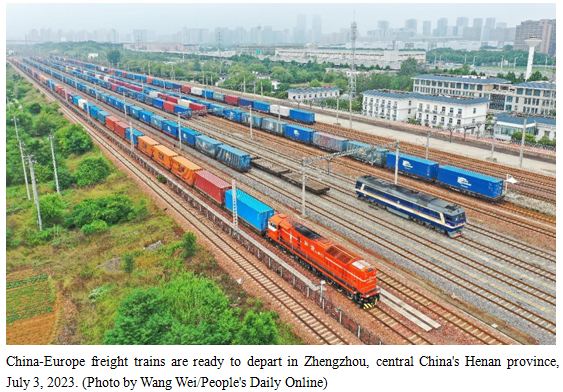By Du Haitao, People’s Daily
China’s H1 foreign trade hits record high. China’s total goods imports and exports expanded 2.1 percent year-on-year to 20.1 trillion yuan (about $2.81 trillion), according to the General Administration of Customs (GAC).
It marked the first time for China’s trade in goods to exceed 20 trillion yuan in the January-June period.
In particular, exports grew 3.7 percent year-on-year to 11.46 trillion yuan.
GAC spokesperson Lyu Daliang said that facing a complicated external environment, China adhered to the general principle of pursuing progress while ensuring stability, steadily promoted high-quality development, and saw stable economic recovery and sustained growth.
In the first half of this year, China’s foreign trade has made breakthroughs with better structure, showcasing strong resilience, he said. Imports and exports kept stable with improved quality, which met expectations.
Noting the sluggish global economic recovery, the contractionary policies adopted by major developed economies, as well as various factors increasing market instability and uncertainty, Lyu said China’s foreign trade has withstood challenges, maintained its scale and improved its quality in the first six months this year.
Foreign trade entities demonstrated obviously stronger vitality. China had 540,000 foreign trade companies with export and import records in the first half of this year, up 6.9 percent year-on-year.
The general trade, which involves longer industrial chains and higher added value, recorded a higher growth rate than the foreign trade in total. The value of general trade accounted for 65.5 percent of the country’s total, up 1.2 percentage points. This indicated the country’s steady improvement in its capability of independent trade development.
Despite the pressure faced by the foreign trade sector, China vigorously expanded emerging markets, built high-level opening up platforms and fostered advantageous industries, continuously building new impetus. The imports and exports via the country’s pilot free trade zones and Hainan Free Trade Port grew 8.6 percent and 26.4 percent, respectively.
The total export value of China’s three major tech-intensive green products – solar batteries, lithium-ion batteries and electric vehicles – soared 61.6 percent year-on-year in the first half of 2023. Together they contributed 1.8 percentage points to the overall export growth during the same period, driving the country’s green industry.
Since this year, the GAC has kept implementing the measures launched in 2022 to stabilize foreign trade. Last month, it adopted 16 measures to further optimize the business environment.
According to preliminary customs statistics, China’s cross-border e-commerce maintained good momentum and grew rapidly in the first half of 2023, with imports and exports jumping 16 percent year-on-year to 1.1 trillion yuan in total.
China has constantly expanded its circle of friends in foreign trade and further diversified the market. In the January-June period, its foreign trade with the ASEAN, Latin America, Africa and Central Asian countries increased 5.4 percent, 7 percent, 10.5 percent and 35.6 percent, respectively, all higher than the overall foreign trade growth.
China’s trade with other Belt and Road countries totaled 6.89 trillion yuan in the first half of 2023, up 9.8 percent year-on-year. In particular, China’s exports of auto parts, lithium-ion batteries, as well as parts of automatic data processing machines to these countries increased 39.3 percent, 34.3 percent and 28.9 percent, respectively.
During the same period, China’s imports of energy and agricultural products from its Belt and Road partners also grew 5.7 percent and 17.9 percent, respectively.
In the first six months, China’s trade with other Belt and Road countries via railway jumped 23.8 percent, maintaining double-digit growth for 12 consecutive months. Such transportation via roads surged 63.3 percent, with a growth rate of over 30 percent for five months in a row.
Over the same period, the trade between China and the ASEAN went up 5.4 percent year-on-year to reach 3.08 trillion yuan, accounting for 15.3 percent of China’s total imports and exports.
In particular, China imported 125.08 billion yuan of agricultural products from the ASEAN, up 7.5 percent, higher than the overall growth of China’s imports from the ASEAN by 6.4 percentage points. Fruit imports stood at 40.54 billion yuan, up 24.1 percent, and palm oil imports hit 10.91 billion yuan with an increase of 120.5 percent.
In the first half of 2023, China’s trade with other 14 members of the Regional Comprehensive Economic Partnership (RCEP) reached 6.1 trillion yuan, up 1.5 percent year-on-year and contributing over 20 percent to China’s foreign trade growth.
The release of the RCEP’s market potential will forcefully promote the free flow of production factors in the region and gradually shape a more prosperous integrated regional market, which opens new space for enterprises to expand international industrial cooperation, as well as economic and trade exchanges.
In the first six months of 2023, China exported 1.72 trillion yuan of intermediate goods to other RCEP countries, accounting for 54.4 percent of the country’s total exports to those economies.



















